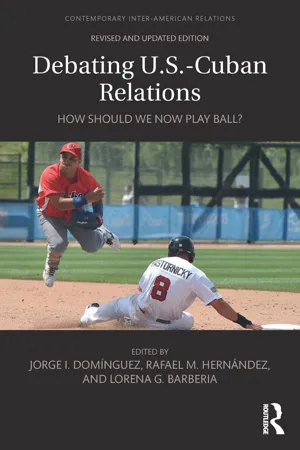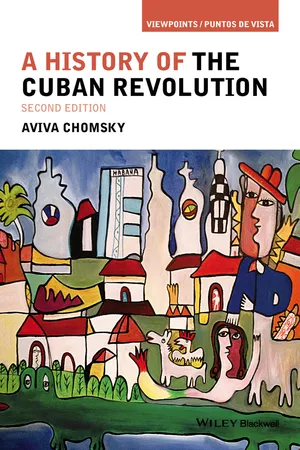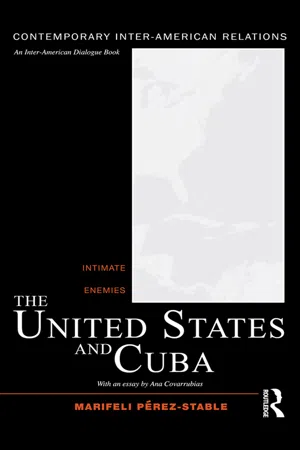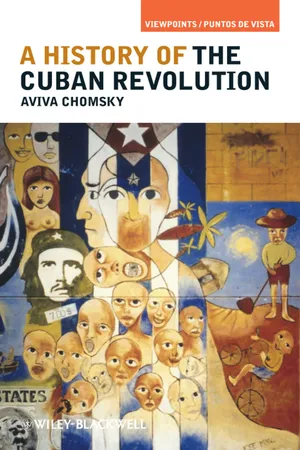History
US Cuban Relations
US Cuban relations have been marked by a complex history of conflict and attempts at reconciliation. Tensions escalated during the Cold War, leading to the Cuban Missile Crisis in 1962. In recent years, there have been efforts to normalize relations, including the reestablishment of diplomatic ties in 2015, although the relationship remains politically sensitive and subject to ongoing debate and negotiation.
Written by Perlego with AI-assistance
Related key terms
Related key terms
1 of 4
Related key terms
1 of 3
6 Key excerpts on "US Cuban Relations"
- eBook - ePub
Debating U.S.-Cuban Relations
How Should We Now Play Ball?
- Jorge I. Dominguez, Rafael M. Hernández, Lorena G. Barberia(Authors)
- 2017(Publication Date)
- Routledge(Publisher)
3 RESHAPING THE RELATIONS BETWEEN THE UNITED STATES AND CUBAJorge I. Domínguez• Cooperative and professional military-to-military relations at the land border.• Cooperative and professional coast-guard-to-coast-guard relations at sea.• Mutually beneficial market-conforming large-scale agricultural trade.• Effective bilateral migration relations agreement between sovereign equals.• Respective peoples value each other’s music, art, and culture.• Longest-lasting highly effective hurricane tracking professional relations.• Large diplomatic missions posted at the respective capital cities.Cuba and the United States were already, in some respects, exemplary neighbors before Presidents Raúl Castro and Barack Obama announced on December 17, 2014, their intention to re-establish formal diplomatic relations and implement other constructive changes in their bilateral relationship. The list above is not social science fiction. It is accurate, even if most works on U.S.-Cuban relations do not start this way because they have highlighted the unrelenting hostility between the two governments. This list is one reason why U.S.-Cuban relations may now build on a good foundation.When in the late 1980s I wrote my chapter for U.S.-Cuban Relations in the 1990s,1 such a list could not have been written. Cooperative and professional bilateral military and coast-guard relations had yet to develop around the U.S. base near Guantánamo (hereafter GTMO)2 and in the Straits of Florida. U.S. agricultural exports to Cuba, and Cuban payment in cash for them, seemed unthinkable. A bilateral migration agreement, signed in 1984, suspended, and then restarted in 1987, would be changed greatly in 1994–95. It was not difficult to imagine that bilateral academic and cultural relations might some day improve but that had yet to happen. Long-lived and successful relations between the Miami and Havana weather bureaus suggested the promise of increased bilateral cooperation on environmental and scientific issues but such wider prospects had yet to be realized. Only the diplomatic representation in each other’s capital cities was in place. Nevertheless, the late 1980s and early 1990s was a significant turning point in the history of U.S.-Cuban relations and in the relations between each country and the world. With the collapse of the Soviet Union and the end of the Cold War in Europe, the international system changed dramatically, also reshaping U.S.-Cuban bilateral relations more than the authors of U.S.-Cuban Relations in the 1990s - eBook - ePub
Contemporary U.S.-Latin American Relations
Cooperation or Conflict in the 21st Century?
- Jorge I. Domínguez, Rafael Fernández de Castro, Jorge I. Domínguez, Rafael Fernández de Castro(Authors)
- 2016(Publication Date)
- Routledge(Publisher)
3 The United States and Cuba Intimate Neighbors? Marifeli Pérez-Stable DOI: 10.4324/9781315731711-3On December 17, 2014, President Barack Obama said what no other U.S. president had ever said. “Today, America chooses to cut loose the shackles of the past so as to reach for a better future – for the Cuban people, for the American people, for our entire hemisphere and for the world.”1The goal of American policy, Obama said, is to “end an outdated approach that, for decades, has failed to advance our interests” and normalize relations for the sake of the Cuban people. He addressed Cubans on the island, the ordinary citizens who struggle to make breakfast, lunch, and dinner for their families, the ones who say “No es fácil” – it isn’t easy.Nearly 53 years earlier, Dwight D. Eisenhower had broken diplomatic relations with Havana. Since the 1970s, other presidents had tried to ease tensions but their efforts had come to naught. Although the Cold War shaped U.S. policy, the U.S.–Cuba relationship had accumulated strains well before the revolution. Such is the history between a great power and a weaker neighbor, especially one with a strong sense of itself. At heart, this chapter argues that the United States and Cuba have never had normal relations even when embassies operated in Washington and Havana until 1961.2Over the course of the twentieth century, the United States and countries in the Caribbean Basin normalized relations, at least to the extent possible in the face of such power differentials. The revolutionary leadership’s decision to align their government with the Soviet Union preempted Cuba’s opportunity to normalize relations with the United States. In short, Cuban leaders also bear responsibility for the rupture and the long-enduring tensions.Had there been a peaceful transition from Fulgencio Batista’s dictatorship in the 1950s, Cuba would surely have had an opportunity to normalize relations with the United States under more auspicious circumstances. Instead, the United States and Cuba were challenged to find a modicum of normality during the Cold War. At first, Washington focused on destabilizing the revolutionary government via the Bay of Pigs invasion and the CIA-sponsored Operation Mongoose. For its part, the Cuban leadership pursued domestic and foreign policies that fueled the American alarm at having a Soviet ally 90 miles from Key West. During the Ford and Carter administrations, the United States and Cuba approached a crossroads of normalization. For the most part, Washington and Havana never quite manifested the will or the patience needed to end their enduring enmity. Even after the Cold War, with democracy taking hold in the former Eastern Europe and democratic transitions in Latin America, the United States embraced the idea of regime change in Havana. Not until President Obama made his historic announcement did the United States and Cuba finally begin the slow process of easing the long-entrenched tensions. - eBook - ePub
- Aviva Chomsky(Author)
- 2015(Publication Date)
- Wiley-Blackwell(Publisher)
People from around the world went to Cuba after the Revolution – some to support the revolutionary process, and some to try to undermine or overthrow it. Cubans also went around the world – some to escape the Revolution, some to work against it, and some to act in solidarity with revolutionary movements elsewhere, especially in Africa and Latin America. Cuba after the Revolution achieved a high diplomatic profile as well, becoming a leader in the Non-Aligned Movement. And the foreign policies of other countries – in particular, the United States and the USSR – were influenced by, and in turn influenced, the Cuban Revolution.This chapter and the next look at how Cuba’s relations with the world shaped the Cuban Revolution, and how the Cuban Revolution shaped the country’s relations with the world. We will also look at the global importance and impact of the Revolution. Because the relationship with the United States was so fundamental to the shape and direction of the Revolution, we’ll begin there.The United States and Cuba
Accounts of United States–Cuba relations since 1959 tend to fall into two categories. Some privilege the Cold War context, emphasizing the Communist nature of the Revolution, Cuba’s ties with the USSR, and the Cold War ideologies that motivated U.S. policies during the second half of the twentieth century. Other, revisionist histories in the United States – as well as the majority of Cuban historians – consider the U.S. imperial stance towards the Caribbean and Latin America, which predated both the Cold War and the Revolution, as the most important analytical framework.Cuban singer-songwriter Silvio Rodríguez exemplified the latter stance in a song about the 1979 Nicaraguan Revolution and the U.S. response. “Now the eagle is suffering from its greatest pain,” he wrote. “It is hurt by Nicaragua because it is hurt by love. It is hurt by children being healthy and going to school, because it can’t sharpen its spurs that way.”2 - eBook - ePub
The United States and Cuba
Intimate Enemies
- Marifeli Pérez-Stable(Author)
- 2011(Publication Date)
- Routledge(Publisher)
THE UNITED STATES AND CUBA HAVE NEVER HAD NORMAL RELATIONSThe Cold War, it is often said, has not ended for the United States and Cuba. Yet a key source of tension between the United States and Cuba—the dynamics between a great power and its weaker neighbor—antedates the U.S.–U.S.S.R. conflict. Pursuing what it saw as its Manifest Destiny during the nineteenth and early twentieth centuries, the United States never considered the rightful interests of neighbors like Cuba.1 Indeed, “what was good for the United States was good for Cuba” could have been the motto stamped on the U.S. calling card. For its part, Cuba viewed the United States with ambivalence: admiration for U.S. democracy and progress, mistrust of U.S. presumptuousness. The island, moreover, had an uncommon expectation of equality that Washington rarely considered. As a result, the United States and Cuba have never had normal ties.In the years before Fidel Castro came to power in 1959, the two countries had failed to establish a stable, mutually beneficial relationship as Mexico and the United States had done after 1940. When the revolution aligned Cuba with the former Soviet Union, U.S.–Cuba relations grievously deteriorated. More than two decades after the fall of Communism in Europe, Washington and Havana are still far from resolving their long-standing predicament: How can the great power learn to take into account Cuban sensibilities as its weaker neighbor turns geographic proximity to the United States into an asset? Because the Cold War so estranged the two countries, normalizing relations years after it ended has not been easy for either party. Nor will it be. Without doubt, Cold War legacies burden the prospect of ending a fifty-year enmity that has served neither country well. But they do precisely because, as the superpowers faced off against each other, Cuba upended Washington’s expectations of loyalty. A brief period of détente in the 1970s opened a door to a U.S.–Cuba rapprochement that ultimately closed. Had it not, a book about Cuba and the United States after the Cold War would not have been subtitled Intimate Enemies - eBook - ePub
- Antonella Mori(Author)
- 2019(Publication Date)
- Ledizioni(Publisher)
4. The EU’s Relations with Cuba from a Regional PerspectiveAnna AyusoRelations between Cuba and Europe have undergone transformations conditioned by the regional scenario in which both actors are framed. The sui generis decolonisation process that placed Cuba under the influence of the United States was radically truncated by the Cuban revolution led by Fidel Castro, which positioned the island in the Soviet orbit and changed the priority of its international relations. At the same time, throughout the process of creation, deepening, and broadening of the European regional integration process from the European Economic Community (EEC) to the current European Union, there were different stages in the relations with Cuba with repeated conflict episodes due to political discrepancies27 . For decades, relations between Brussels and Havana were hindered by the Common Position adopted by the EU Council in 1996, which prevented progress in relations until democratic reforms were made in the country.However, relations have gradually been strengthened within the regional framework of the EU’s bi-regional strategic partnership with Latin America and the Caribbean (LAC) initiated at the Rio Summit in 1999. This process of rapprochement culminated in the signing of the Political Dialogue and Cooperation Agreement (PDCA) between Cuba and the European Union in December 2016. Through this treaty, the EU put an end to the policy of unilateral pressure through democratic conditionality and normalised relations with the Cuban regime that, for almost six decades, remained under the control of the brothers Fidel and Raúl Castro. This change has taken place in parallel with a slow process of economic and political transformation on the island, the most symbolic of which was the transfer of power from Raúl Castro to Miguel Diaz-Canel on 19 April 2018. This step implied both a generational change in the leading of the country and a perpetuation of a regime based on a one-party system. - eBook - ePub
- Aviva Chomsky(Author)
- 2010(Publication Date)
- Wiley-Blackwell(Publisher)
Accounts of United States–Cuba relations since 1959 tend to fall into two categories. Some privilege the Cold War context, emphasizing the Communist nature of the Revolution, Cuba’s ties with the USSR, and the Cold War ideologies that motivated U.S. policies during the second half of the twentieth century. Other, revisionist histories in the United States – as well as the majority of Cuban historians – consider the U.S. imperial stance towards the Caribbean and Latin America, which predated both the Cold War and the Revolution, as the most important context.Cuban singer-songwriter Silvio Rodríguez exemplified the latter stance in a song about the 1979 Nicaraguan Revolution and the U.S. response. “Now the eagle is suffering from its greatest pain,” he wrote. “It is hurt by Nicaragua because it is hurt by love. It is hurt by children being healthy and going to school, because it can’t sharpen its spurs that way.”1 According to this perspective, the United States seeks economic gain from Latin America, and often opposes real democracy and economic development there because these would reduce the U.S. ability to exploit its neighbors.In many ways, conflict between the United States and the Cuban Revolution was inevitable. In its emphasis on nationalism, and on redistributive social justice, the Revolution challenged half a century or more of U.S. domination of the island, and the economic and political model that it had imposed. Immediately after the Revolution, U.S. officials hoped and believed that they could manipulate and rein in the new Cuban government, in particular with regard to how it would treat U.S. investors. Over the course of 1959, policymakers grew increasingly discouraged about their ability to control the course of events. By the end of 1959, the U.S. government had moved to implacable hostility towards the Revolution and determination to overthrow it.Between 1959 and the present, the United States has attempted a dizzying array of tactics and methods in its attempt to control, and then to undermine, overthrow, or destroy the Cuban revolutionary experiment. Many of them were covert. The Ministry of the Interior Museum in Havana offers a testament to the many attempts at sabotage and assassination carried out by U.S. agents. The U.S. public knew little about these until 1975 Senate Hearings where CIA and other officials testified to their involvement in assassination attempts against Fidel Castro. Despite the publicity at the time, this history remains relatively unknown in the United States, although it is common knowledge in Cuba.
Index pages curate the most relevant extracts from our library of academic textbooks. They’ve been created using an in-house natural language model (NLM), each adding context and meaning to key research topics.
Explore more topic indexes
Explore more topic indexes
1 of 6
Explore more topic indexes
1 of 4





